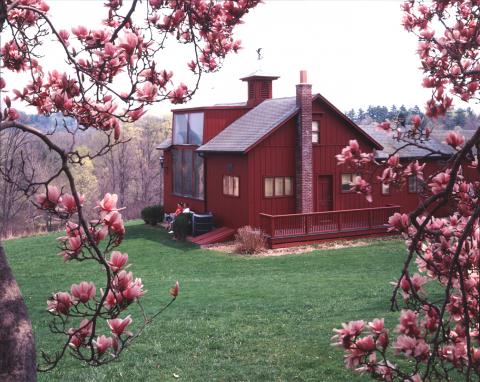
The Berkshires: The Norman Rockwell Museum
The lovely Berkshires town of Stockbridge is home to the Norman Rockwell Museum as well as his work studio, moved from Main Street after his death in compliance with a stipulation in his will. I checked out the studio first, where it had been planted on a hill with an amazing pastoral view.
Instead of maintaining it as it was at the time of his death, the studio was re-set to 1960, with reproductions of classic art (Michelangelo’s “David,” Brueghel, Picasso, etc) on the walls and an antique etching machine in the corner (he didn’t use it, just liked the looks of it). It was a clean, neat, minimalist space and the staff guide implied that Rockwell was a bit on the anal retentive side. He also seems to have had a hearty affection for himself, providing the gold to preserve his studio, museum, and reputation and putting himself into 92 of his paintings.
I returned to the main museum building to hear a gallery talk by a guide named Judy, who was more charming performer than art historian – a suitable introduction to Rockwell. I admit to having arrived with more curiosity than serious expectations, but in the end found the Rockwell Museum to be a thoughtful, fascinating destination.
Born in 1894, Rockwell got his start drawing illustrations to the books – like Dickens – that his father read to him. In the middle of high school he convinced his family to let him go straight to art school and by 1916, at age 22, he scored two commissions for cover art for the Saturday Evening Post, thus starting his life as an illustrator at the pinnacle of the profession. His first cover set the tone for the work he would do for the Post for many years: good-natured joshing by two boys of another who is dutifully pushing a baby pram down the sidewalk.
This light-hearted world of family and kids and American apple pie grew old on Rockwell when the Post refused to let him depict any of the people’s pain during the Depression. He finally made a break from the Post during the 60s, when Look Magazine said he could have a free hand. He wanted to talk about racism and the civil rights movement and, in fact, produced his iconic “The Problem We All Live With” in 1964 depicting a dignified young Black girl being escorted to school by US Marshalls. The point of view is focused on her and on the tomato that has smashed on the wall behind her, while we only see the Marshalls from their shoulders and official armbands down. The following year Rockwell produced the powerful painting, “Murder in Mississippi,” of the very moment that the activists Chaney, Goodman, and Schwerner were slayed. Instead of painting-in the Klansmen, he just showed their shadows. He had a way, in these and other works, of bringing the viewer’s eye to the crucial point.
During my visit, I had the treat to peruse, in the special exhibit, the 323 Saturday Evening Post covers that Rockwell produced between 1916 and 1963. What a stroll down memory lane – most of them memories I must have inherited through the ether, being before my time.
There was something so interconnected about The Berkshires experience: among the Post covers were teasers for a story by Edith Wharton, whose home I had visited earlier, and a piece about Dorothy Thompson, the journalist who was the protagonist in the play I had seen at Shakespeare and Company the night before. While I would not have been part of that white, privileged, Christian New England in-crowd, I thoroughly enjoyed my peek at their posh lives. Apparently I’m not the only plebe fan: the Normal Rockwell Museum has already received 200,000 visitors this year.
PHOTO CREDIT: Norman Rockwell's Studio. Norman Rockwell’s original Stockbridge studio (exterior). Photo by Art Evans. ©Norman Rockwell Museum. All rights reserved.
Sue Katz, an author, journalist, blogger and rebel, used to be most proud of her martial arts career and her world travel, but now it’s all about her edgy blog Consenting Adult. Sue is a regular contributor to Open Media Boston.

